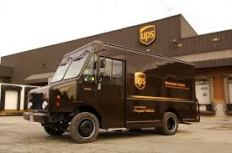 It’s satisfying and reassuring to meet with someone who confirms expectations. When Corey Wright explained how four separate UPS distribution facilities in Portland OR were reengineered to process 100,000 packages an hour and how the Worldwide Distribution hub in Louisville, KY processes 500,000 packages an hour during plane transfers, he gave time and scale to what I already knew was an impressive logistical feat. But I always learn more when I discover ancillary aspects of a process that I never knew existed. So when Corey explained UPS’s drive to add value to a commodity service (shipping) and how they deal with their biggest competition (Amazon, not Federal Express) I marveled anew at the complexity of our world.
It’s satisfying and reassuring to meet with someone who confirms expectations. When Corey Wright explained how four separate UPS distribution facilities in Portland OR were reengineered to process 100,000 packages an hour and how the Worldwide Distribution hub in Louisville, KY processes 500,000 packages an hour during plane transfers, he gave time and scale to what I already knew was an impressive logistical feat. But I always learn more when I discover ancillary aspects of a process that I never knew existed. So when Corey explained UPS’s drive to add value to a commodity service (shipping) and how they deal with their biggest competition (Amazon, not Federal Express) I marveled anew at the complexity of our world.
Corey is an executive in UPS’s Lending Division, one of the ways UPS ‘creates value’ by differentiating itself from other delivery services.
 Why does a shipping company lend money? For the same reason General Motors has GMAC – to get more people to use their product. GM’s incentive is linear; they lend direct to consumers to buy GM products. UPS’s lending is one step removed from the consumer. They loan money to companies whose products require shipping. When UPS lends money to a T-shirt manufacturer, they lock in all the shipping that company requires. Besides, UPS, like many companies flourishing in the technology sector, is flush with cash (to the tune of $2 billion). They can lend money at one or more percentage points less than a bank and come out with a higher total return because of the increased shipping their investment generates.
Why does a shipping company lend money? For the same reason General Motors has GMAC – to get more people to use their product. GM’s incentive is linear; they lend direct to consumers to buy GM products. UPS’s lending is one step removed from the consumer. They loan money to companies whose products require shipping. When UPS lends money to a T-shirt manufacturer, they lock in all the shipping that company requires. Besides, UPS, like many companies flourishing in the technology sector, is flush with cash (to the tune of $2 billion). They can lend money at one or more percentage points less than a bank and come out with a higher total return because of the increased shipping their investment generates.
 But how is UPS, a delivery service, a high-tech company? UPS, and is its companion Fed Ex, are two of the largest ‘traditional company’ beneficiaries of online retailing. They may not be growing as fast as Amazon (15%) Target online (36%) or Wal-Mart online (18%), but all those online sales need to be shipped. High-tech revenues trickle down to UPS and Fed Ex.
But how is UPS, a delivery service, a high-tech company? UPS, and is its companion Fed Ex, are two of the largest ‘traditional company’ beneficiaries of online retailing. They may not be growing as fast as Amazon (15%) Target online (36%) or Wal-Mart online (18%), but all those online sales need to be shipped. High-tech revenues trickle down to UPS and Fed Ex.
So why does UPS see Amazon as more competition than Federal Express? “In the future, we’re not looking at companies competing. We’re looking at supply chains competing. Amazon is at the genesis of the buy/sell relationship. They drive every aspect of the market. Every component – payment, finance, distribution, delivery, customer service – all used to be different parties. Not anymore. Amazon does it all. UPS is just a piece of the puzzle.” Amazon sets tight contracts with UPS and Fed Ex and plays them off each other. It also has the option of going into the delivery business itself. “If you send a two-pound box of cookies, it will cost about thirteen dollars. Amazon might pay us four dollars, but they charge even less. Amazon subsidizes over $3 billion a year in shipping costs because people perceive the value of free shipping as two to three dollars.”
How does the United States Post Office play into package delivery? “There is no political will to get rid of the post office, so it is here to stay for some time. However, I can see a time when Washington embraces Amazon leveraging the back of the house. We’ll still have USPS mail carriers, but that’s about it.”
What are the limits to this increased amount of shipping? “The last mile is always the hardest and most expensive.” Wal-Mart stores get the consumer to handle the last mile. They assemble everything you want in one place convenient to home and you go and pick it up. Online retail brings goods directly to your home. “But no one is home. We are going to see more designated locations, small-scale neighborhood locations, where people can pick up their packages. The stores holding the packages might get a small fee, but they’ll also get increased foot traffic.” Another factor will be decentralized production. “We already have 3-D printers in Louisville. When sellers get an order, they simply send the electronic file to Louisville, where the 3D item is printed and then shipped to the final destination.” The number of shipment legs has been cut in half. “Once the 3D printer is in your town, or in your home, you’ll just order the file for what you want. Delivery will disappear.”
How will we live tomorrow?
 “I’m tying to keep it simple. If you look over time, we are all trying to meet Maslow’s Hierarchy of Needs.
“I’m tying to keep it simple. If you look over time, we are all trying to meet Maslow’s Hierarchy of Needs.
“How we’ll live depends on how resources are allocated. Look at the places where people now live that were uninhabitable but technology made viable. How will we be able to sustain that?
“Look at how communities react to challenges. The Salem Witch Trials and ISIS are examples of people responding to what they don’t know in fear. We’re on earth for such a short time. I hope that we can retain our individual liberties and maintain our collective will.
“Bottom line, I don’t know but it’s fun to speculate. Personally, I am fortunate and comfortable. For most Americans, debt is the single biggest challenge to a satisfying life. Beyond the US, the question is how do we create stable societies? “




The quotes today about living tomorrow with more shopping and shipping services left me with some thoughtful discomfort: Sentence #1: “For most Americans, debt is the biggest challenge to a satisfying life. #2: Beyond the US, the question is how do we create stable societies?” If sentence #1 is true, then we need to do all we can to encourage Americans to be responsible citizens with realistic expectations, not consumers who buy more than they can afford while hoping that more stuff will make them satisfied and happy. Sentence #2 relates within the US, not just “beyond”. How do we create stable societies? Live within our means. Save on the good days so that we have a safety net for the bad days and can help others. Use less disposable stuff such as gasoline, cardboard, plastic. Purchase what we need and can use, not what we want and can store or toss. Live in energy efficient homes that are only as large as necessary, not as big as we can go into debt for and show off in. Be models of stability to our children, grandchildren and beyond.
LikeLike
Jeanne – Thank you for your thoughts. There is not always complete consistency between what we do today and how we project onto tomorrow. It is one of the intriguing paradoxes of many of the people who speak with me.
LikeLike